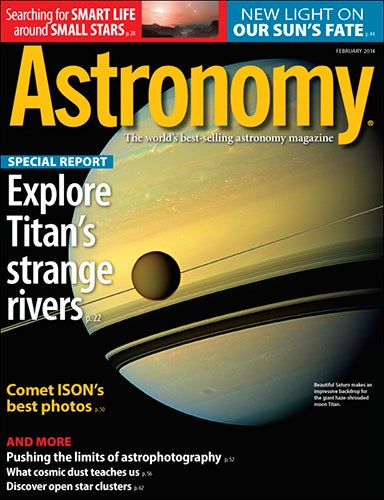
Waukesha, Wis. – Since landing the Huygens probe on Titan nine years ago, scientists have learned an immense amount about the largest saturnian moon. Photographs taken while the probe fell through the atmosphere combined with recent images from the Cassini spacecraft show what look like river channels feeding giant lakes on the surface and also clouds and perhaps rainstorms in the atmosphere. While researchers know Titan can’t harbor water, they think it might hold a different type of liquid: methane. Science writer Robert Zimmerman writes about this possibility in “Does methane flow on Titan?”
To map the satellite’s surface, scientists use Cassini’s radar instrument. Unfortunately, this method doesn’t provide the same detail as a photograph would – it can tell them only what surface regions are smooth, rough, hilly, or have similar characteristics. But they’ve still gleaned a lot about the surface, including evidence of “several new lakes forming shortly after a storm burst,” writes Zimmerman. “Radar images taken several years later showed that these dark patches had disappeared, once again implying that they had dried up.”
Read more about the possible liquid cycle on Titan’s surface and how scientists have unraveled the evidence in the February 2014 issue of Astronomy magazine, on newsstands January 7.
“Searching for smart life around small stars”
While astronomers once thought low-mass red dwarf stars would be poor locations for life to evolve, they have recently become much more optimistic. This type of star lives much longer than massive, and even Sun-like, stars. They’re also the most common type in the galaxy. For these reasons, and others – which SETI researcher Seth Shostak describes in “Searching for smart life around small stars” – scientists are gearing up quests to investigate nearby red dwarfs. “If you look at 1,000 red dwarfs instead of the same number of type G stars, the dwarfs will be only half as far away, on average,” writes Shostak. “The signals from a hypothetical E.T. civilization will be four times stronger and easier to find.”
“New light on our Sun’s fate”
In about 6.5 billion years, our Sun will be a carbon-oxygen cinder called a white dwarf. Astronomers know this and many more details about and the Sun’s evolutionary path from observing other stars like ours. Astrophysicist Jason Kalirai – who was recently selected as Maryland’s 2013 Outstanding Young Scientist – writes about stellar evolution in “New light on our Sun’s fate.” His research team calculated how much material the Sun and other stars of similar mass will lose throughout their lives.
“Explore the Trumpler classes of clusters”
In 1930, Robert Julius Trumpler published his greatest contribution to astronomy, a paper detailing the distances, dimensions, and space distribution of 334 open clusters of stars. Within it, he divided those clusters into 36 types. In “Explore the Trumpler classes of clusters,” Senior Editor Michael E. Bakich describes the astronomer’s history, research, and how you can observe these different types of clusters.
February night-sky events visible without optical aid
- February 1 – Mercury, just beyond its peak, passes 5° south of the Moon.
- February 11 – The Moon passes 5° south of Jupiter.
- February 15 – Venus shines at magnitude –4.9, the brightest it gets.
- February 25 – The Moons passes 0.4° north of Venus.
Also in the February 2014 Astronomy
- “What are we learning from cosmic dust?” -Tiny particles in the solar system may answer some of its biggest questions.
- “Where other astrophotographers fear to tread” – Thomas V. Davis is committed to shedding light on the dusty, dark parts of the universe through his portraits of nebulae.
- “Comet ISON’s opening act” – The most anticipated comet in decades got off to a good start.
- “Astronomy tests Levenhuk’s new refractor” – The Ra R110 ED Doublet OTA offers high-quality optics, good portability, and nice styling – all at a great price.
- “The Sky this Month” – Exclusive star charts guide you through February’s night sky.
- The February issue of Astronomy also includes Astro News, Ask Astro, Snapshot, Breakthrough, Bob Berman’s Strange Universe, Stephen James O’Meara’s Secret Sky, Glenn Chaple’s Observing Basics, Tony Hallas’ Cosmic Imaging, Erika Rix’s Astro Sketching, Cosmic World, Letters, Web Talk, New Products, Reader Gallery, and Final Frontier.









